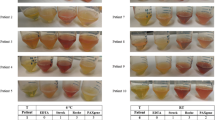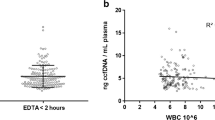Abstract
During colorectal cancer (CRC) development tumor-derived cell-free DNA (cfDNA) can be released into the bloodstream. Many different cfDNA isolation methods and specific blood collection tubes preventing the release of genomic DNA and stabilizing cfDNA with preservative reagents became available. These factors may affect greatly on the further liquid biopsy analyses. Our aim was to test different blood collection tubes and cfDNA isolation methods to determine whether these factors influence the cfDNA amount and the promoter methylation of four previously described hypermethylated biomarkers. Three manual isolation methods (High Pure Viral Nucleic Acid Large Volume Kit; Epi proColon 2.0 Kit; Quick-cfDNA™ Serum & Plasma Kit) and automated sample preparation systems (InviGenius and InviGenius PLUS) were examined. Furthermore, K3EDTA Vacuette tubes and Streck Cell-Free DNA BCT® tubes were compared. After cfDNA isolation and bisulfite conversion of samples, the methylation level of SFRP1, SFRP2, SDC2, and PRIMA1 were defined with MethyLight assays. We have ascertained that there are differences between the cfDNA amounts depending on the isolation methods. Higher cfDNA yield was observed using InviGenius system than column-based manual isolation method; however, InviGenius PLUS has produced lower cfDNA amounts. No remarkable variance could be found between K3EDTA and Streck tubes; slightly higher cfDNA quantity was detected in 60% of plasma samples using Streck tubes. In point of methylation level and frequency, manual column-based isolation produced more consistent results. Automated cfDNA extraction systems are easy-to-use and high-throughput; however, further improvements in the isolation protocols might lead to the increase of the sensitivity of further methylation analysis.




Similar content being viewed by others
References
Ferlay J, Shin HR, Bray F, Forman D, Mathers C, Parkin DM (2010) Estimates of worldwide burden of cancer in 2008: GLOBOCAN 2008. Int J Cancer 127(12):2893–2917
Forde KA (2006) Colonoscopic screening for colon cancer. Surg Endosc 2:S471–S474
Janz T, Lu K, Povlow MR, Urso B (2016) A review of colorectal cancer detection modalities, stool DNA, and fecal immunochemistry testing in adults over the age of 50. Cureus 8(12):e931
Inadomi JM (2017) Screening for colorectal neoplasia. N Engl J Med 376(2):149–156
Grady WM, Carethers JM (2008) Genomic and epigenetic instability in colorectal cancer pathogenesis. Gastroenterology 135(4):1079–1099
Kim MS, Lee J, Sidransky D (2010) DNA methylation markers in colorectal cancer. Cancer Metastasis Rev 29(1):181–206
Ehrlich M (2002) DNA methylation in cancer: too much, but also too little. Oncogene 21(35):5400–5413
Kurdyukov S, Bullock M (2016) DNA methylation analysis: choosing the right method. Biology (Basel) 5(1)
Diaz LA Jr, Bardelli A (2014) Liquid biopsies: genotyping circulating tumor DNA. J Clin Oncol 32:579–586
Lam K, Pan K, Linnekamp JF, Medema JP, Kandimalla R (2016) DNA methylation based biomarkers in colorectal cancer: a systematic review. Biochim Biophys Acta 1866(1):106–120
Schwarzenbach H, Hoon DS, Pantel K (2011) Cell-free nucleic acids as biomarkers in cancer patients. Nat Rev Cancer 11(6):426–437
van der Vaart M, Pretorius PJ (2008) Circulating DNA. Its origin and fluctuation. Ann N Y Acad Sci 1137:18–26
Thierry AR, Mouliere F, Gongora C, Ollier J, Robert B, Ychou M, Del Rio M, Molina F (2010) Origin and quantification of circulating DNA in mice with human colorectal cancer xenografts. Nucleic Acids Res 38(18):6159–6175
Jung K, Fleischhacker M, Rabien A (2010) Cell-free DNA in the blood as a solid tumor biomarker--a critical appraisal of the literature. Clin Chim Acta 411(21–22):1611–1624
Malentacchi F, Pizzamiglio S, Verderio P, Pazzagli M, Orlando C, Ciniselli CM, Günther K, Gelmini S (2015) Influence of storage conditions and extraction methods on the quantity and quality of circulating cell-free DNA (ccfDNA): the SPIDIA-DNAplas external quality assessment experience. Clin Chem Lab Med 53(12):1935–1942
Tamkovich SN, Cherepanova AV, Kolesnikova EV, Rykova EY, Pyshnyi DV, Vlassov VV, Laktionov PP (2006) Circulating DNA and DNase activity in human blood. Ann N Y Acad Sci 1075:191–196
Patutina O, Mironova N, Ryabchikova E, Popova N, Nikolin V, Kaledin V, Vlassov V, Zenkova M (2011) Inhibition of metastasis development by daily administration of ultralow doses of RNase A and DNase I. Biochimie 93(4):689–696
Patel PS, Patel BP, Rawal RM, Raval GN, Patel MM, Patel JB, Jha FP, Patel DD (2000) Evaluation of serum alkaline DNase activity in treatment monitoring of head and neck cancer patients. Tumour Biol 21(2):82–89
Xue X, Teare MD, Holen I, Zhu YM, Woll PJ (2009) Optimizing the yield and utility of circulating cell-free DNA from plasma and serum. Clin Chim Acta 404(2):100–104
Tóth K, Barták BK, Tulassay Z, Molnár B (2016) Circulating cell-free nucleic acids as biomarkers in colorectal cancer screening and diagnosis. Expert Rev Mol Diagn 16(2):239–252
Barták BK, Kalmár A, Péterfia B, Patai ÁV, Galamb O, Valcz G, Spisák S, Wichmann B, Nagy ZB, Tóth K, Tulassay Z, Igaz P, Molnár B (2017) Colorectal adenoma and cancer detection based on altered methylation pattern of SFRP1, SFRP2, SDC2, and PRIMA1 in plasma samples. Epigenetics. https://doi.org/10.1080/15592294.2017.1356957
Medina Diaz I, Nocon A, Mehnert DH, Fredebohm J, Diehl F, Holtrup F (2016) Performance of Streck cfDNA blood collection tubes for liquid biopsy testing. PLoS One 11(11):e0166354
Crowley E, Di Nicolantonio F, Loupakis F, Bardelli A (2013) Liquid biopsy: monitoring cancer-genetics in the blood. Nat Rev Clin Oncol 10(8):472–484
Romero A, Acosta-Eyzaguirre D, Sanz J, Moreno F, Serrano G, Díaz-Rubio E, Caldés T, Garcia-Saenz JÁ (2015) Identification of E545k mutation in plasma from a PIK3CA wild-type metastatic breast cancer patient by array-based digital polymerase chain reaction: circulating-free DNA a powerful tool for biomarker testing in advance disease. Transl Res 166(6):783–787
Henriksen SD, Madsen PH, Larsen AC, Johansen MB, Drewes AM, Pedersen IS, Krarup H, Thorlacius-Ussing O (2016) Cell-free DNA promoter hypermethylation in plasma as a diagnostic marker for pancreatic adenocarcinoma. Clin Epigenetics 8:117
Schmidt B, Beyer J, Dietrich D, Bork I, Liebenberg V, Fleischhacker M (2015) Quantification of cell-free mSHOX2 plasma DNA for therapy monitoring in advanced stage non-small cell (NSCLC) and small-cell lung cancer (SCLC) patients. PLoS One 10(2):e0118195
Fleischhacker M, Schmidt B, Weickmann S, Fersching DM, Leszinski GS, Siegele B, Stötzer OJ, Nagel D, Holdenrieder S (2011) Methods for isolation of cell-free plasma DNA strongly effect DNA yield. Clin Chim Acta 412(23–24):2085–2088
Huang DJ, Zimmermann BG, Holzgreve W, Hahn S (2005) Use of an automated method improves the yield and quality of cell-free fetal DNA extracted from maternal plasma. Clin Chem 51(12):2419–2420
Kang Q, Henry NL, Paoletti C, Jiang H, Vats P, Chinnaiyan AM, Hayes DF, Merajver SD, Rae JM, Tewari M (2016) Comparative analysis of circulating tumor DNA stability in K3EDTA, Streck, and CellSave blood collection tubes. Clin Biochem 49(18):1354–1360
Norton SE, Lechner JM, Williams T, Fernando MR (2013) A stabilizing reagent prevents cell-free DNA contamination by cellular DNA in plasma during blood sample storage and shipping as determined by digital PCR. Clin Biochem 46(15):1561–1565
Denis MG, Knol AC, Théoleyre S, Vallée A, Dréno B (2015) Efficient detection of BRAF mutation in plasma of patients after long-term storage of blood in cell-free DNA blood collection tubes. Clin Chem 61(6):886–888
Toro PV, Erlanger B, Beaver JA, Cochran RL, VanDenBerg DA, Yakim E, Cravero K, Chu D, Zabransky DJ, Wong HY, Croessmann S, Parsons H, Hurley PJ, Lauring J, Park BH (2015) Comparison of cell stabilizing blood collection tubes for circulating plasma tumor DNA. Clin Biochem 48(15):993–998
Acknowledgements
This study was supported by the ÚNKP 16-3 New National Excellence Program of The Ministry of Human Capacities (ÚNKP-16-4-DSZ-2016-0010), by the National Research, Development and Innovation Office (KMR-12-1-2012-0216 grant) and by the Hungarian Scientific Research Fund (OTKA-K111743 grant).
Author information
Authors and Affiliations
Corresponding author
Ethics declarations
Conflict of Interest
The authors declare that they have no competing interests.
Rights and permissions
About this article
Cite this article
Barták, B.K., Kalmár, A., Galamb, O. et al. Blood Collection and Cell-Free DNA Isolation Methods Influence the Sensitivity of Liquid Biopsy Analysis for Colorectal Cancer Detection. Pathol. Oncol. Res. 25, 915–923 (2019). https://doi.org/10.1007/s12253-018-0382-z
Received:
Accepted:
Published:
Issue Date:
DOI: https://doi.org/10.1007/s12253-018-0382-z




